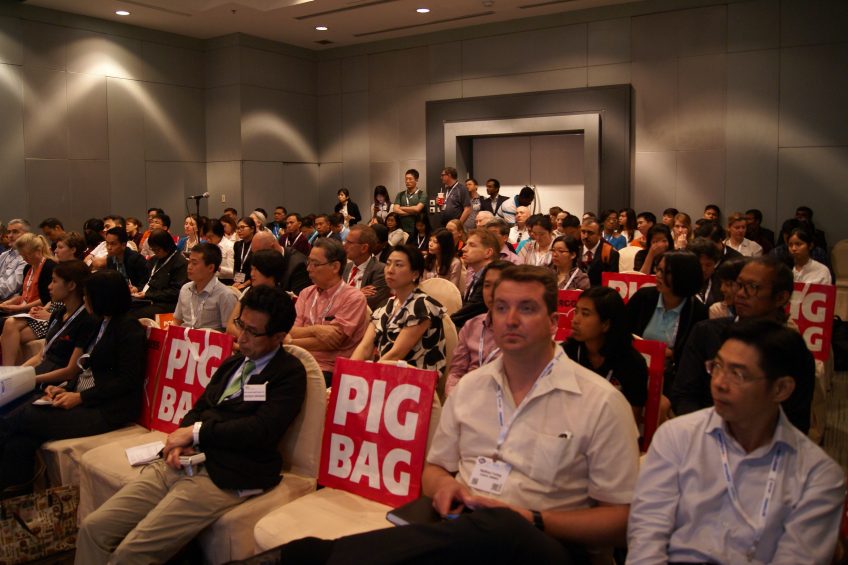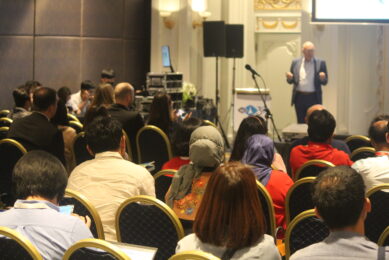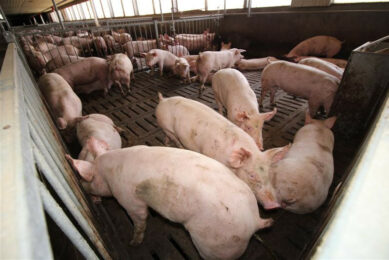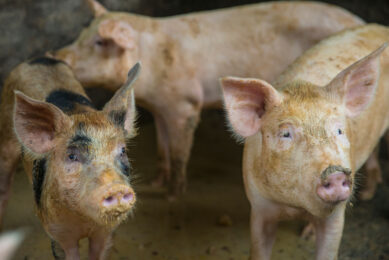Antimicrobial reduction in the spotlight at VIV Asia

Seldom was a subject so topical at VIV Asia, as this year’s theme of antibiotic reduction. Causes, developments and solutions were discussed at Pig Progress’ own event ‘Growth promotion without antimicrobials’ – and there was more to discover.
If there was one message that remained in the minds of the visitors of VIV Asia 2017, it must be that by 2050, about 4.7 million people in Asia alone will die as a result of antimicrobials no longer functioning properly – if we don’t do anything, that is. The figure was taken from the Review on Antimicrobial Resistance 2014, but it was the one fact that came back in virtually all of the presentations relating to the number one hot topic at the moment – antimicrobial resistance and how to avoid it.
Antimicrobial resistance – a global concern
Antimicrobial resistance and how to reduce antibiotic usage have definitely become global themes, that much was made clear. For a decade or longer, mostly experts in the European Union were convinced that usage of antibiotics contributed to the creation of antimicrobial resistance, while in large parts of the world, the ideas often failed to break through – and if they did, they were often strongly challenged and criticised. With now the United States also embarking on a reduction programme, many Asian countries are following suit, with initiatives in e.g. China and Vietnam.
So no wonder then, that Dr Sasi Jaroenpoj, DVM, of the Thai Department of Livestock Development (DLD) also talked about the future potential casualties in Asia, when he discussed the topics in the context of Thailand, being the host of VIV Asia – and being a leading agribusiness nation in South East Asia. Pig Progress had invited him to do so at the seminar ‘Growth Promotion Without Antibiotics’. Being the head of the DLD’s Animal Feed and Veterinary Product Standard Section, and having regular contacts at the World Health Organization (WHO), the Food and Agriculture Organization (FAO) and the World Organization for Animal Health (OIE), he explained what initiatives Thailand is currently taking.
Root cause driving antimicrobial resistance
Having mentioned the ‘One Health’ principle, i.e. that the antimicrobial resistance problem is much bigger than veterinary science alone, he first turned to causes in Asia and in Thailand specifically, where pig farms still lack incentives to turn to exporting markets, compared to the poultry industry. Dr Sasi said, “Introducing prudent use guidelines is not enough and promoting alternative products may be useless, if we neglect the root cause that drives antimicrobial resistance. It is the supply chain and demand of cheap drugs with active pharmaceutical ingredients (API) and the amounts of drugs in feed. These facts alone support the arbitrary use of ‘miracle drugs’, the results of which could be achieved by good farm management practices too.”
Co-operation in tracking and tracing drugs
Co-operation is needed, he said, between authorities, the private sector and both domestically as well as across borders, to track and trace drugs, especially API, and medicated feed. In this context he pointed to Japan and the European Union. When ingredients like colistin or amoxicillin premixes are registered in Japan or the EU, it happens in very low concentrations. In South East Asia, however, these concentrations are much higher.
Dr Sasi said, “After being sold, they usually go directly to the farms and thus this practice contributes to the irrational use of drugs in feed in Asia. Besides, the farm mixer may not have the capability of mixing it well. The lack of restrictions on medicated feed production, the high concentration of medicated premixes, including the uncontrolled access to antibiotics without veterinary oversight, could drive antimicrobial resistance rates in Asia higher than in Europe.”
The Thai solution plan
As a result of growing messages of resistance, the Thai government recently took steps to curb the usage of antibiotics. In 2015 the use of antimicrobial growth promoters was banned. As a next step, in 2016, Thailand embarked on a new national strategy, further reducing antimicrobial usage and resistance, Dr Sasi explained.
This new plan is following the One Health principle, and also includes hospitals and pharmacies next to focusing on agriculture. For the food production business, the Thai plan aims to achieve at least a 30% reduction in antimicrobial usage in the next five years. This is achieved through at least five measures, he explained:
– Improving the regulations to optimise the use of antibiotics – this includes for e.g.
- a reclassification of antibiotics;
- the control of in-feed drugs; reserving four groups of critically important antimicrobials for treatment only (polymyxin, cephalosporins, fluoroquinolones and beta-lactams);
- tighter control of distribution channels of APIs, antibiotics and medicated feed and stricter law enforcement when drugs are used illegally
– Promoting farm standards and co-operation of all sectors;
– Setting up a national antimicrobial resistance surveillance programme as well as a training programme;
– Sharing information about antimicrobial resistance; and
– Promoting rational drug use in livestock – this includes the implementation of international standards and the co-operation with the veterinary council to develop good practices.
Approach taken by the pig industry
Not only are there initiatives from the Thai authorities, Dr Sasi explained, individual companies have also decided to implement programmes to achieve a reduction or withdrawal medication programme of antibiotics. Often, these plans revolve around a stepwise approach, including restriction, reduction and sometimes even rejection – a process that should lead to a total withdrawal medication programme of antibiotics by 2020, in major integrated farms that covers 50% of Thailand’s pig population.
Various solutions can be used in Thailand as alternatives to antibiotic growth promoters, Dr Sasi said. Obviously, the DLD and the Thai pig industry is trying to strengthen biosecurity systems on-farms. In addition, various private farms have carried out trials with probiotics and gut health products. He also mentioned the importance of the regulation to assess and control the application of (autogenous) vaccination as well as Thai herbs.
Which further tools are available for pork producers in Asia and all around the world, was the key message of 2 further speakers at the Pig Progress event. In particular, during the vulnerable time after weaning, there is a need for solutions to avoid post-weaning diarrhoea.
Dr Sasi concluded saying that Thailand focuses and learns from European experiences within the Asian context. He plans to discuss and share the Thailand model at the upcoming ASEAN working group on livestock (ASWGL) at its annual meeting this April in Brunei.
Innovad: Improving gut integrity
Dr Milena Sevastiyanova, speaking on behalf of a feed additives and nutraceutical manufacturer Innovad (Belgium), zoomed in on a key role of ‘gut integrity’ and microflora balance to stop/reduce antibiotics and ZnO. Animals with good gut integrity and balanced lumen microbiota definitely increase their performance, she said. Apart from having a direct antibacterial effect, she identified additional targets, being e.g. reducing inflammation, reinforcing tight junctions, an energy source and enhancing villi proliferation, to name a few.

She touched on a company’s intestinal health product, Lumance, a complex and precise formula combining all benefits of short-chain and medium-chain fatty acids, essential oils and alkaloids and tannin rich plant extracts. She touched on each ingredient individually and explained why their precise combination makes the formula successful. The product is formulated with esterified butyric acid (mono-, di- and try-esters). Mono-butyrins have been shown to have a stronger antibacterial activity against E. coli and Salmonella compared with butyric acid. At the same time, butyrate is known to contribute to lactobacilli growth in the gut. Chosen botanicals in the formula are well proven for their strong anti-inflammatory action and enforce antibacterial activity, she added.
She referred to various farm trials in Italy, Bulgaria, Belarus, Spain. The results showed that the product is capable of completely replacing colistin in pigs and reducing zinc oxide when dealing with post-weaning diarrhoea, but at the same time the pigs without antibiotics perform far better. To summarise, she said, the formula improves productive performance on top of stopping or reducing antibiotic and zinc oxide treatments.
ISN on alternative protein sources
It is not only the addition of feed additives that might be a way of helping piglets get through the difficult time after weaning – feed ingredients may too, said Dr Hagen Schulze, who spoke on behalf of ISN, part of AB Agri. He explained that by making an informed decision on the quality, consistency and efficacy of feed ingredients, producers can make positive steps towards antibiotic-free feeding systems. When piglets are trying to get used to other types of feed after weaning, it is essential to make sure that care, hygiene and quality of the feeds are optimal, he said. For a series of reasons, he indicated, high-quality alternative proteins can be an ideal way of enhancing digestion and performance – think of the consistency of the quality, the reduction of anti-nutritional factors, high nutrient and energy availability or the high palatability.

He introduced AlphaSoy 530, a product created by Agrokorn, a Danish company which was acquired by AB Agri in 2016. This soy protein is being manufactured in a four-step thermo-mechanical process including enzymic processing. Dr Schulze showed the results of various feed intake and growth performance trials from the US, the UK and Denmark which demonstrate that even without antibiotics and replacing more expensive protein rich ingredients, animal performance could be maintained or even at times improved with careful management, good protocols and the inclusion of this product in the diet. In addition, one of the effects of the alternative protein source is that it enhances feed intake and reduces gut inflammation.











